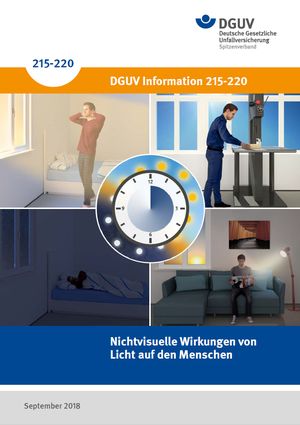KANBrief 4/18

Some years ago, a receptor type was discovered in the human eye that is particularly sensitive to radiation in the blue range of the visible light spectrum. Through this receptor – besides other non-visual channels – light influences the human biological clock, the circadian rhythm, sleep, important body functions and well-being.
In 2013, DIN published a specification containing detailed planning recommendations concerning the non-visual effects of light. The specification also covered work premises. Since scientific findings underpinning such detailed recommendations for application did not exist and the recommendations impacted upon the safety and health of workers at work, KAN responded with a comment from an OSH perspective. (NOTE: this comment was last updated in September 2022: KAN position (pdf)) At the same time, manufacturers have developed lighting systems of this kind further and strongly promoted their health effects. Users lacked information however on the opportunities and risks associated with these systems, and recommendations on application specifically from an occupational safety and health perspective were not available. Two KAN workshops (KANBrief 2/18) finally provided an appropriate platform for constructive discussions between the OSH lobby, the research community, industry bodies and the social partners. The result was that important activity was launched, including on the part of the OSH community.
KAN has commissioned a literature review containing the first compilation of scientific findings regarding the non-visual effect of light with specific reference to occupational safety and health (pdf,in German). Based upon the results, the parties commissioned with conducting the review formulated research questions relevant to occupational safety and health, and KAN addressed recommendations to the DGUV, research institutes and other parties.
DGUV Informative publication (in German) 215-220 (9/2018) concerning the non-visual effects of light upon human beings, produced by the DGUV Lighting Subcommittee, is based upon the results of the KAN literature review. Although the findings regarding the non-visual effects of light are still incomplete, it is necessary for companies and workers to be informed of the relevance to health, and for initial recommendations and guidance to be provided on the use of light at the workplace. This is particularly relevant in view of the trend, still topical, for LEDs with a high blue component in the colour spectrum (daylight white) to be used at many workplaces owing to their high energy efficiency. Used at the wrong time of day, these products can however impact negatively upon the sleep/wake rhythm. Since the non-visual effects of light arise at all times of the day and night, the DGUV Informative publication contains supplementary information for the periods before and after work and on non-working days.
On behalf of the OSH community, the Institute for Prevention and Occupational Medicine of the German Social Accident Insurance – an institute of the Ruhr University Bochum (IPA) and the Federal Institute for Occupational Safety and Health (BAuA) are conducting research into the topic of light. The IPA is studying the effects of light in shift work upon hormones, sleep and further parameters, and the potential role of melatonin – a hormone the release of which is suppressed by light at night – in the incidence of breast cancer. One of the BAuA's planned research projects concerns the influence of light upon alertness during the day as a function of the light's spectral composition and the duration of exposure to it.
The BAuA is also coordinating the new European NoVEL (Non-Visual Effects of Light) research network. The purpose of this network is to promote the pooling of experience in the sphere of non-visual effects of light and circadian research, to focus the activities of the network's member institutions, and to conduct larger-scale joint research projects.
The OSH lobby still has much to do. KAN must adjust its position to the developments described above. The ASTA state committee on work premises is discussing whether to include the non-visual effects of light in the ASR A3.4 Technical Rule for work premises. The DGUV Informative publication describes the status quo, and is reviewed regularly and if necessary updated.
Which tasks should in the view of the OSH lobby be assumed by standards institutes in this area, such as adopting requirements concerning the information for use of lamps, are still the subject of discussion. KAN continues to monitor European and international standardization activity closely and is pursuing dialogue with employers, employees, the lighting industry and other parties concerned.
Gerold Soestmeyer Dr Anna Dammann
beleuchtung@bgrci.de dammann@kan.de